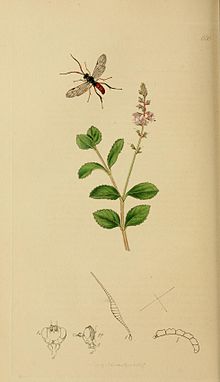Brief Summary
provided by Catalog of Hymenoptera in America North of Mexico
This is the only genus in the Eucerotinae; it is moderate sized, and its distribution is Holarctic, Australian (one undescribed sp.), and Ethiopian (one Madagascan sp.). The genus was placed in the Tryphoninae (as tribe Eucerotini) by Townes (1969), apparently based upon the similarities between the final instar larvae of Euceros and Exenterus (cf. Finlayson [1960, p. 34]), but the egg, the early larval instars, the adult, and the biology of Euceros differ so greatly from those of Tryphoninae or any other Ichneumonidae that the genus is here placed in a subfamily of its own, as was done by Perkins (1959). Barron (1977) has published a revision of the Nearctic species; I regret that it was not feasible for me to revise the present treatment of Euceros accordingly. ~Euceros eggs are stalked and greatly resemble those of Chrysopidae; they are deposited on foliage near early-instar larvae of a carrier host (defoliating sawflies or Lepidoptera). The planidial first larval instar of Euceros remains upon its empty chorion at the top of the egg stalk until it is able to attach to a passing carrier host. Although a Euceros planidium obtains enough fluid from the carrier host to sustain itself, it is an obligate hyperparasite and cannot develop frther on the carrier host; its chance for completing its development depends upon the host being parasitized (presumably most often subsequently) by another ichneumonid (it seems reasonable to expect rearings from larger Braconidae also). The time at which a Euceros planidium enters its true host is not known for certain and may vary according to the true host's mode of parasitism (true hosts include external as well as internal parasites). When the true host is an internal larval parasite (e.g. Phobocampe or Olesicampe), it appears likely that the first-instar Euceros planidium remains externally attached to the carrier host until the mature larva of the true host has killed the carrier host and emerged from it. When the true host is an internal larval-pupal parasite (a species of Anomaloninae being recorded as a host of Euceros frigidis Cresson) it would be necessary for the Euceros planidium to bore through the integument of the carrier host in order to reach the true host. There appear to be seven or eight larval instars; during the first four stadia, the Euceros larvae are internal parasites, but during the last three or four stadia they are external parasites.
- bibliographic citation
- Catalog of Hymenoptera in America North of Mexico. 1979. Prepared cooperatively by specialists on the various groups of Hymenoptera under the direction of Karl V. Krombein and Paul D. Hurd, Jr., Smithsonian Institution, and David R. Smith and B. D. Burks, Systematic Entomology Laboratory, Insect Identification and Beneficial Insect Introduction Institute. Science and Education Administration, United States Department of Agriculture.
Euceros: Brief Summary
provided by wikipedia EN

Euceros albitarsus Curtis Illustration from
British Entomology Euceros is a worldwide genus of ichneumon wasps in the family Ichneumonidae. It is the sole genus of the subfamily Eucerotinae.
Euceros species are hyperparasitoids of Ichneumonoidea. First instar larvae hatch from eggs laid on leaf surfaces, attach to passing Lepidoptera or Symphyta larva and enter the body of an emerging primary endoparasitoid, such as a campoplegine or banchine or an attached ectoparasitoid. The genus has been variously placed in Tryphoninae and Ctenopelmatinae.
- license
- cc-by-sa-3.0
- copyright
- Wikipedia authors and editors



 Euceros albitarsus Curtis Illustration from British Entomology
Euceros albitarsus Curtis Illustration from British Entomology